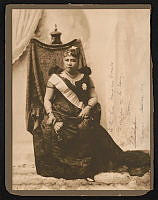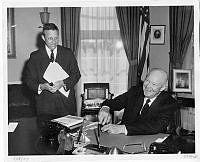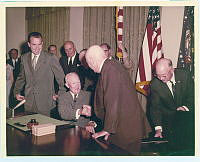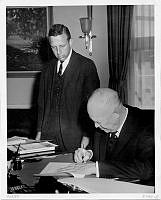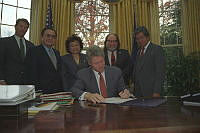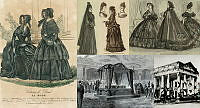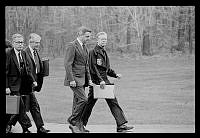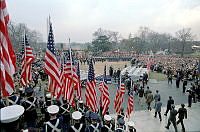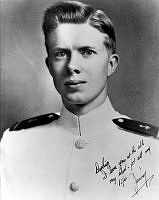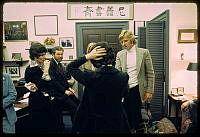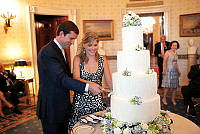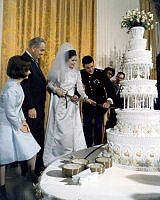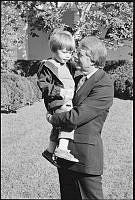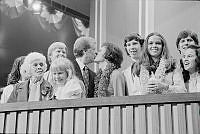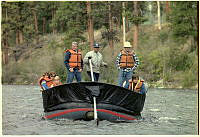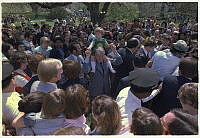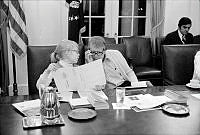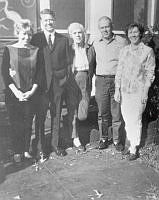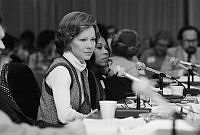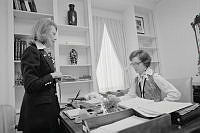Jimmy Carter would say later, "No matter who was with me, we watched the big grandfather clock by the door." Time was running out, for it was Tuesday, January 20, 1981. The scene was the Oval Office. In just hours this president would leave it for good, and a new leader, Ronald Reagan, would move in. As the clock ticked the time away, Carter tried to resolve a crisis that had almost destroyed his presidency. He was close, very close, and as he said, "At stake were the lives of 52 precious human beings who had been imprisoned in Iran for 444 days–and almost 12 billion dollars of Iranian assets." 1
Download Lesson Plan
Prelude
The beginnings of this crisis preceded Jimmy Carter’s term by almost thirty years. For that long, the United States had provided political support and, more recently, massive military assistance to the government of the shah of Iran. Iran was important because it provided oil to the industrial West and separated the Soviet Union from the Persian Gulf and the oil states. The United States had an enormous stake in keeping it stable and independent. By 1979, however, when Carter had been in office three years, the shah was in trouble, reaping the harvest of years of brutal and unpopular policies, including the use of secret police that controlled dissent with arbitrary arrests and torture.2 It was clear that the shah had lost the support of his people, but the president hoped a coalition of the moderate opponents might be formed. The stability of the country, though, was being threatened by a religious fanatic, the Ayatollah Ruhollah Khomeini, who did not like the shah’s efforts to modernize and Westernize a fiercely religious, fundamentalist society. In January 1979, the shah fled into exile, and the theocratic regime of Khomeini took power. There was little informed understanding in the U.S. government about the political implications of this fundamentalist regime. Gary Sick, who was on the National Security staff, recalled a meeting in which Vice President Walter Mondale asked the Central Intelligence Agency director Stansfield Turner, "What the hell is an ‘Ayatollah’ anyway." Turner said he wasn’t sure he knew.3 In the beginning, the Carter administration made some effort to establish a relationship with the new government, but by late 1979 it seemed futile. Up until this crisis, few Americans seemed aware of the deep resentments that many Iranian people continued to harbor toward the United States, a country they considered a symbol of Western intrusion into their society.4 Part of the problem stemmed from the desire of the shah, in October 1979, to come to New York City for cancer treatment. Many Iranians remembered a time in 1953 when the prime minister of Iran had challenged the authority of the shah, who in turn, fled the country. However, with the help of a CIA-supported coup, the monarch’s power was restored.5 Now Carter understood that if he allowed the deposed shah to come to the United States., Khomeini’s government would interpret the move as another example of the West’s arrogant interference in Iran’s affairs. Though Carter understood it was a politically volatile decision, he permitted the shah to come, based on a long alliance and "humanitarian principle." American diplomats in Iran met with the prime minister of the Ayatollah’s government to test reaction to the president’s decision. Though deeply opposed to this U.S. move, the prime minister gave assurances that the Iranian government would protect the safety of diplomatic personnel in Tehran.
Days later, on November 4, a mob of 3,000 militants invaded the American embassy in Tehran, taking sixty-six diplomats and military personnel as hostages. The more moderate Iranian prime minister resigned in protest, and Khomeini was in full control. The militants demanded a return of the shah in exchange for the hostages. In the meantime, despite the fact that the Carter administration had arranged for the shah to leave the United States for Panama, the crisis continued unabated. In April 1980, after months of negotiations failed to result in the release of the hostages, the United States broke off diplomatic relations with Iran. Carter approved a hostage rescue mission by an elite paramilitary unit, the American commandos led by Colonel Charles Beckwith.6 It was a dismal failure. Several military helicopters broke down in the desert, and eight commandos died when two aircraft collided during the hasty retreat. The abortive mission seemed to many Americans a symbol of U.S. military weakness in the post-Vietnam era. Carter’s popularity plunged to 20 percent, even lower than Nixon’s during the Watergate scandal.7
The Iranian hostage crisis contributed greatly to Jimmy Carter’s loss of the presidency in the 1980 election. Americans had lost confidence in their leader. It wasn’t difficult. Each night television newscasts relayed images of angry anti-American mobs outside the embassy in Tehran, shouting "Death to America," "Death to Carter."8 The creation of the television program, Nightline, devoted strictly to discussion of the crisis, was a blatant reminder of Carter’s failure to secure the hostages’ release. Each night TV news commentators posted the number of days the hostages had been held in humiliating, terrifying captivity, their president impotent in finding a way to bring them home. "This is the 325th day of the Iranian hostage crisis," the journalists would say, and on and on it went. Election day was the anniversary of the seizure, an irony that wasn’t lost on the American people, who voted for Ronald Reagan by large margins.
Now the clock was ticking inexorably toward the last moment of Carter’s time in office. He would later say that in those last weeks, the return of the hostages was almost an obsession with him. In his memoir, Keeping Faith, he explained:
Of course, their lives, safety, and freedom were the paramount considerations, but there was more to it. I wanted to have my decisions vindicated. It was very likely that I had been defeated and would soon leave office as President because I had kept these hostages and their fate at the forefront of the world’s attention, and had clung to a cautious and prudent policy in order to protect their lives during the preceding fourteen months. Before God and my fellow citizens, I wanted to exert every ounce of my strength and ability during these last few days to achieve their liberation.9
It seemed within reach. After months of negotiations the United States had agreed to release several billion dollars in Iranian gold and bank assets, frozen in American banks just after the seizure of the embassy. The government of Iran, now involved in a war with neighboring Iraq, was desperate for money and therefore seemed willing to release the hostages.10 The Iranians refused to communicate directly with the president, or any other American, so Algeria had agreed to act as an intermediary. This arrangement slowed down the negotiating process. As Carter recalled, "The Iranians, who spoke Persian, would talk only with the Algerians, who spoke French. Any question or proposal of mine had to be translated twice as it went from Washington to Algiers to Tehran, and then the answers and counterproposals had to come back to me over the same slow route."11 Much of the money involved was being held in overseas branches of twelve American banks, so Carter, his cabinet, and staff were constantly on the phone to London, Istanbul, Bonn, and other world capitals to work out the financial details.
Time Crunch
Jimmy Carter had come back to the Oval Office from a "working weekend" at Camp David that Sunday, January 18. Except for a few breaks, he remained in that office until fifteen minutes before the Reagans arrived to begin the inaugural ceremonies. Every force within the government that Carter controlled was poised to accomplish the mission, and now it seemed possible. Carter had already talked to personnel at the U. S. military hospital in Wiesbaden, West Germany, where the hostages would stay for a few days before "re-entry" into the United States. The president hoped to greet them there before his term was out.
Then came a series of small, nerve-racking crises that slowed down the process. At one time that last Sunday, Lloyd Cutler, one of the White House attorneys, told the president there was a delay in the transfer of assets–the Federal Reserve Bank of New York did not have its part of the money! Fortunately, funds were shifted among the reserve banks and the problem was solved. Another difficulty concerned the time difference between Washington and Tehran. Because of the war with Iraq, the Iranian officials had blackouts of airport lights. This meant that once it got dark in Iran (about 9:30 a.m. Washington time), even if the deal had been sealed, the Algerian pilots would not take off until dawn. Thus, if the departure time passed, everyone understood that it would be another eight to ten hours before anything could happen. Work continued through a long night. About 2:00 a.m., the president ordered blankets from the White House steward, and he and Cutler each stretched out on a couch to rest while they waited for news from the negotiations.12 Sometime in the early morning, word came that the planes were on the runway in Tehran, and the hostages had been taken to the vicinity of the airport. The Algerians had even agreed to depart after dark if it was absolutely necessary. Finally, the phone call came through. "We have a deal," Jimmy Carter said, beaming. Someone popped a bottle of champagne. At 4:44 a.m. Carter went to the press briefing room to announce that with the help of Algeria the United States and Iran had reached an agreement.13 Certain "implementation" steps in the agreement needed to be settled, and the hostages would be free.
Then came another delay. The Algerian negotiator sent word that the Iranian bank officials did not agree with the terms of accountability in the banking agreements. They wouldn’t cooperate. The planes were returned to their standby position. Hours passed, and still no word came that the problem had been resolved. A Carter aide had calculated that the president would have to leave Washington no later than 2:00 p.m. Monday afternoon if he wanted to see the hostages in Wiesbaden and be back in time for the inauguration. Hamilton Jordan, White House chief of staff, asked the president if he had to go to the inauguration. Carter reminded Jordan that the inauguration was a symbol of the continuity of the government. Yes, despite the importance of the negotiations, he did need to attend! The staff soon understood that Carter’s trip to Germany to greet hostages would not occur until after the inauguration. The president switched from worrying about seeing the hostages before the end of the term, to worrying that the entire negotiation process could disintegrate. Carter talked with Deputy Secretary of State Warren Christopher, who was in communication with the Algerian foreign minister. He told Christopher to warn the Algerians that the Carter presidency would end the next day at noon. "After that," he said, "neither Christopher nor I could speak for the United States, and the entire negotiating process might have to begin anew."14
In the wee hours of Tuesday, January 20, came some promising news. The processes required to move the money through the proper channels were almost completed. Only a few small details were to be ironed out. At 6:35 a.m., Christopher sent a message: "All escrows were signed at 6:18. The Bank of England has certified that they hold $7.977 billion, the correct amount." Now the bank would send word to Algiers by telex or phone, which would notify Iran. At 7:45 a.m., with messages still coming in fast and furious, Rosalyn Carter brought her husband a razor, telling him, "You need a shave." The barber was with her, to give Carter’s hair a trim before the inaugural ceremonies. Rosalyn remembered that as she was leaving the Oval Office to go back upstairs, Jimmy answered one more call, and then yelled out for everyone to hear: "Flight 133 is loaded and ready for take-off." Once more, there came elation, cheers, and hugs. At 8:04 a.m., Algeria confirmed that the bank certification was complete, and the Algerians were notifying Iran. That was it! Every step was complete. Per the agreement, Iran would move to "immediately bring about the safe departure of the 52 nationals detained in Iran."15
Still Carter lingered in the Oval Office. Word had not yet come that the hostages had left the ground in Tehran. At 9:45 a.m., Christopher called one last time and told Carter takeoff would be by noon, but, as a security measure, the Iranian officials did not want the word released until the hostages were out of Iranian airspace. President Carter said the United States would comply. Then Rosalyn came to the door, and said, "Jimmy, the Reagans will be here in fifteen minutes. You will have to put on your morning clothes and greet them."16
After the inauguration, a Secret Service agent pushed through the crowd at the U.S. Capitol to tell former president Jimmy Carter that at 12:33 p.m. the first plane carrying the hostages had taken off from Tehran, and the second one had left nine minutes later. President Ronald Reagan got the word at an inaugural luncheon. It was the first official announcement he would make to the American people. The hostages, on the 444th day of their captivity, were set free. The republic rejoiced!
















